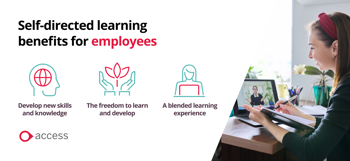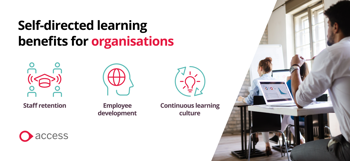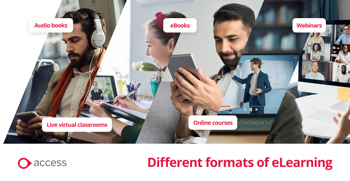What are the benefits of self-directed learning in the workplace?
With the increase in employees actively seeking out their own learning endeavors and organisations recognising the value of nurturing this culture, self-directed learning should be an integral part of an organisation's L&D strategy.
This article will explore what self directed learning is including the theory behind it, the benefits and how to encourage self-directed learning within the workplace.
What is self-directed learning?
Imagine having the freedom to drive your own learning journey, just like navigating your favourite streaming service.
Self-directed learning is a self-guided approach which puts the learner at the forefront of their educational journey. This allows them to take ownership of their learning process and set their unique goals and achievements. In a workplace setting while the responsibility is shifted to the learner, the organisation must also support them on their journey with suitable resources and a cultural shift.
A recent report carried out by Capterra noted that every worker should “become a serial learner, where self-motivation, resilience and persistence, similar characteristics of a serial entrepreneur, will help you advance in your career".
Self-directed learning promotes:
- elevated performance
- enhanced engagement and staff retention
- continuous learning
Self directed learning can take on a variety of formats to suit all types of eLearning preferences and requirements, for example:
- audiobooks
- live virtual classrooms
- eBooks
- online courses
- webinars
Employees should be empowered to seek out learning opportunities which are personalised and self directed and, driven by employees’ intrinsic motivation to grow rather than extrinsic mandates from management. It is only when we empower this self directed learning approach do we unlock the full benefits of having a high-impact learning culture in the workplace.
The theory of self directed learning
Now we have explained what self-directed learning is, we are going to touch upon the theory behind it. While it can be a complex topic, there are certain aspects of the theory that will help to contextualise the type of learning and aid organisations in how to implement it.
Sometimes referred to as self-led learning or self-regulated learning, the approach is discussed within ‘Self-Directed Learning in the Workplace’ by Sunyoung Park.
In the article he states:
“Self-directed learning (SDL) has been an influential adult learning concept within the field of adult education for more than three decades. However, according to trends in self-learning and self-development, the workplace culture is becoming increasingly important in the success or failure of meeting learning objectives.”
The theory of self-directed learning can be traced back to the work of Malcolm Knowles, who formalised it in 1975 in his book, "The Adult Learner: A Neglected Species" Knowles' approach underscores the significance of self-directed learning, aligning with the first principle of andragogy:
"Adults need to be involved in the planning and evaluation of their instruction."
In essence, this principle recognises that adults possess the capacity to identify their own learning needs.
Looking past traditional learning methods provides organisations with:
- a fresh perspective on learning in the workplace,
- an emphasis on individual autonomy and self-regulation
- a departure from out of date, one-size-fits-all approaches
It is the responsibility of Learning and Development departments to create a learning environment that not only acknowledges this capacity but also equips it.
Did you know?
The Access Self Directed learning platform powered by Bookboon has reported that the typical employee usage rate exceeds 40% per year, which is 3-4 times higher than the industry average for digital learning tools.
What are the benefits of self-directed learning?
There are plenty of self-directed learning benefits both for the user and for the business. Let’s explore the self-directed learning benefits and how the approach can empower individuals and organisations alike.
Self-directed learning benefits for employees
Benefits of self directed learning for employees

Develop new skills and knowledge
When employees are given the option to learn what they want in a style that most suits them, they are more likely to expand their learning and explore topics that they may not have considered before. Whether it’s for a career goal or personal interests, they have the freedom to learn new skills.
The freedom to learn and develop
By learning anywhere at any time, employees have the freedom to learn when and how they want to. An online platform that is also available via mobile means that materials can be accessed on demand at a time that best suits the learner.
A blended learning experience
Not everybody absorbs information in the same way, so providing learners with different methods, they can find what they find the most effective. By offering a range of diverse learning materials, different learning styles and schedules can be accommodated.
Self-directed learning benefits for organisations
Benefits of self directed learning in the workplace

Staff retention
According to the 2023 Linkedin Learning report, three of the top five factors that drive people to pursue new jobs reflect their desire to stretch, grow, and develop new skills.
These factors are:
- Doing challenging and impactful work
- Opportunities for career growth within the company
- Opportunities to learn and develop new skills.
With the demand for targeted and tailored learning chosen by the learner, it’s no surprise that self-directed learning can play a key role in this.
Employee development
By embracing the self-led learning approach, organisations are likely to see their employees push themselves and strive to learn more, as well as share their newfound knowledge with colleagues. This kind of passion often leads to development and leaders to emerge within your teams.
Continuous learning culture
Cultivating a strong learning culture involves investing in the training and development of your employees. When you encourage and support self-directed learning, your workforce will be motivated to embrace different learning methods and push themselves to reach their full potential.
What are the essential aspects of self-directed learning?
In order for self-directed learning to be truly embedded into the culture of an organisation, there are certain factors that come into play. These come from both the learner and the organisation.
Motivation to learn
Underpinning self-directed learning should be the employee’s willingness to learn new skills and knowledge. This motivation can stem from personal interests, career goals, or a desire to improve performance. Without their drive to seek out and actively participate in learning, the process will likely fail so understanding the employee’s specific needs will help them acquire new skills and knowledge.
Autonomy and responsibility
Handing the trust over to employees who have their own workload to manage alongside career development opportunities will require work from both sides. Employees must be allowed the freedom to choose what and how they learn but they must also take responsibility for their development.
A robust self-directed learning platform
In order to support employees with their self-directed learning journey, organisations must be able to provide enough breadth and depth of resources in order to facilitate this with ease. For example, the Access self directed learning platform powered by Bookboon, offers over 6,000 resources spanning a variety of topics, formats, and languages. This solution therefore caters to a wide range of both development goals and learning styles.
Formats include:
- audiobooks
- eBooks
- online courses and learning journeys
- live virtual classrooms
different formats of Self directed learning

How to encourage self directed learning - 3 Tips
Now let’s discuss arguably the most important part of the journey – how to get uptake in self-directed learning. Whilst the onus is on the employee to guide their learning activities, it should be endorsed and facilitated by the organisation in a number of ways.
Unlocking the power of self-directed learning in the workplace
Including self-directed learning in your L&D strategy will help your employees take ownership of their learning endeavors and embrace learning new skills and knowledge. By adopting this approach and providing useful tools and resources, your organisation can reap the benefits of self-directed learning in the workplace.
This in turn will encourage a continuous learning culture, give your employees a blended learning experience and provide them with the opportunity to take responsibility for their learning.
Explore our Self Directed training solution today!
There are many ways to find out more about Bookboon and how our engaging, learn on demand content can transform the learning culture in your business.

Speak to an expert
Chat with one of our learning experts and find out how Bookboon Professional Development training can be tailored to meet the needs of your business, regardless of size.

Schedule a live demo
Relax and let one of our learning experts showcase the capabilities of Bookboon and find out how it can help transform your organisation.

Discover more Digital Learning Solutions
Access Learning contains all the powerful tools you need to take your organisation to the next level.





